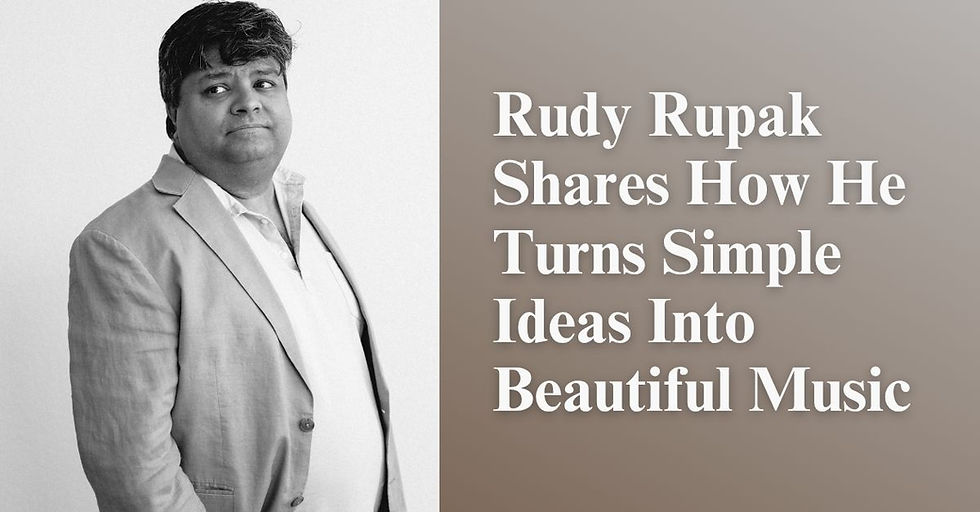Rudy Rupak’s Artistic Vision Connects Music, Film, and Emotion
- Rudy Rupak
- Jul 23
- 3 min read

Rudy Rupak is a visionary creative whose unique ability to bridge the worlds of film and music has positioned him as a powerful storyteller across mediums. With a career that spans decades, Rupak’s work is defined not by genre or format, but by emotion—he creates experiences that resonate deeply with audiences, whether through the screen or through sound.
A Groundbreaking Start in Film
Rupak began making waves in the entertainment industry as one of Canada’s youngest film producers. His early credits include Snowboard Academy (1996), a cult comedy featuring Jim Varney, and She’s Too Tall (1999), which helped establish his eye for narrative-driven entertainment. These projects, now featured on his IMDb profile, demonstrate his early commitment to storytelling that blends humor, relatability, and emotional nuance. From the outset, Rupak proved he could bring a story to life with both commercial appeal and artistic integrity.
Music as a Multilingual Emotional Language
While his career in film developed, Rupak’s passion for music composition matured in parallel. Today, he is an accomplished composer and songwriter who writes and produces music in multiple languages, including English, Hindi, Bengali, and Farsi. His songs are not confined to a single genre; instead, they explore orchestral, electronic, and world music, creating rich, emotive landscapes that draw listeners into a fully immersive experience.
What sets his music apart is its cinematic quality—unsurprising, given his background in film. Each composition tells a story, often mirroring the emotional arcs seen in his screenwriting and production work. His scores are layered, dynamic, and intentionally crafted to evoke visceral responses, echoing the complexity of human emotion.
Blending Mediums with Purpose
For Rudy Rupak, music and film are not separate disciplines—they are interwoven channels through which emotion is expressed and shared. His artistic philosophy views these mediums as complementary forces. Whether he is scoring a scene or writing a standalone piece, he considers the emotional intent first. This rare blend of filmmaker and composer allows him to enhance a film’s storytelling with music that doesn’t just accompany the narrative—it amplifies it.
Rupak’s approach to film scoring exemplifies his ability to use music as a powerful narrative tool. Through a sophisticated blend of orchestral composition and contemporary production techniques, he crafts soundscapes that are both immersive and emotionally resonant, enhancing the cinematic experience with depth and nuance.
A Multicultural, Human-Centered Vision
Rupak’s multicultural heritage is central to his creative identity. His music crosses linguistic and cultural borders, aiming to unify rather than divide. Whether composing a Bengali ballad or a modern electronic track in English, Rupak centers each piece around a core emotional truth that speaks to a universal audience.
This inclusive approach extends to his public speaking and entrepreneurial work. He regularly shares insights about how culture and technology can intersect to create innovative art. He champions the idea that emotion is the common thread connecting us all—an idea that echoes through his cross-genre projects and international collaborations.
Innovation Beyond the Studio
Beyond music and film, Rudy Rupak is also known for his entrepreneurial ventures. He embraces emerging technologies and platforms to expand the reach of his work, from launching multilingual streaming channels to producing content for digital-first audiences. This entrepreneurial mindset allows him to not only create but also distribute meaningful content on a global scale.
Conclusion
Rudy Rupak’s artistic vision is grounded in a deep understanding of emotion as the most powerful tool in storytelling. By seamlessly integrating music and film, he creates work that is not only seen or heard—but felt. His multicultural approach, coupled with his relentless innovation, positions him as a modern creative force with a timeless message: art, in any form, is at its best when it speaks to the human heart.




Comments